
I had been enjoying my three day weekend, especially spending time with my wife. It’s not often that Valentine’s Day falls on a weekend, and when that is combined with the President’s Day holiday the whole weekend becomes an extended lover’s holiday. Gallantry prevents me from further elaboration.
The weekend weather was sunny and warm, although I did not think it too unseasonable for southern Nevada in February, except that it followed an unusually wet January and first-half of February. Contrasted against four weeks of relentless clouds and sprinkles this weekend weather seemed especially nice (another enhancement to the romantic weekend).
I must admit, however, that the change in weather was prompting my thoughts toward fishing. I recently noted that Baker Reservoir was iceless, and that Dacey Reservoir at Wayne Kirch was also partially free of ice and entertaining a float tuber or two, or so indicated the Nevada Division of Wildlife web site. I really didn’t want to take away from the special weekend I was sharing with my bride of thirty years by taking an all-day adventure, but I admit I saw a window of opportunity early Monday morning when I knew she would be sleeping in.

I decided to run up to Cold Creek. Maybe some of the Tasmanian rainbows stocked from Mason Valley Hatchery last October held over from the coldest part of winter. Although I wanted to feel a trout on my line again I really didn’t care if I caught anything; I just wanted to get out in the sun up in the Spring Mountain foothills to clear my thoughts a little before Tuesday brought the budget woes back into my foresight. I grabbed my little home-made seven-and-one-half foot fly rod and my Orvis CFO reel and took off about 8:30 am in order to arrive as the water was warming.
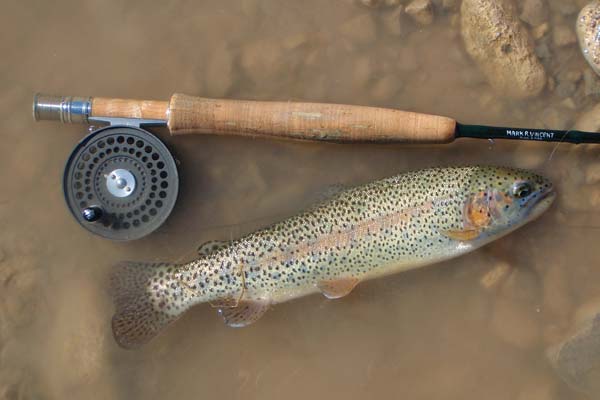
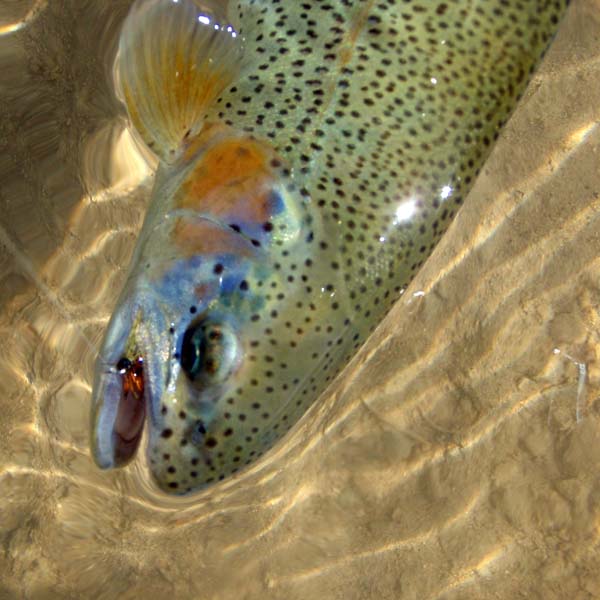
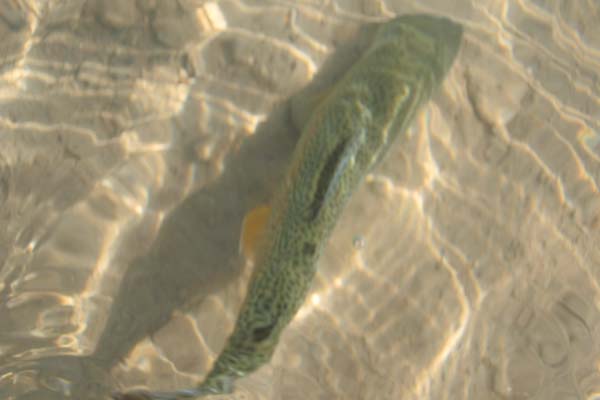
es along the morning. He did not have a sinking line, and was having some trouble getting his fly down to the trout which were obviously closer to the bottom than the surface. He was using Hare’s Ear nymphs that he tied himself dropped from a floating line on which he affixed a foam strike indicator. Despite his inability to get the fly deeper, he hooked up with several fish throughout the morning. I offered him some advice on fishing with sinking lines and I gave him a fly (Callibaetis nymph) and a split shot weight to compensate for his floating line. As I mentioned in my November 11, 2009 blog, I am very partial to sinking or sink-tip lines for lakes, reservoirs, and ponds. My experience is that ninety percent of the time trout feed under the surface and a sinking line will get your fly there more efficiently. A heavily weighted fly or a split shot on the leader can help, but then casting is more difficult and the fly won’t act as natural. I would save the weights for nymphing on steams and creeks, not on still waters. Irrespective of my advice and his tackle limitations, he seemed well on his way to learning the craft.
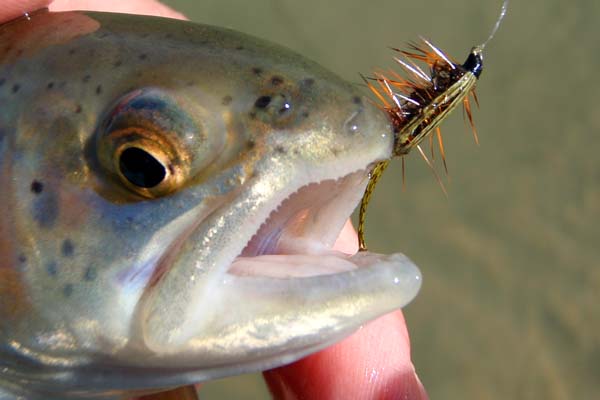
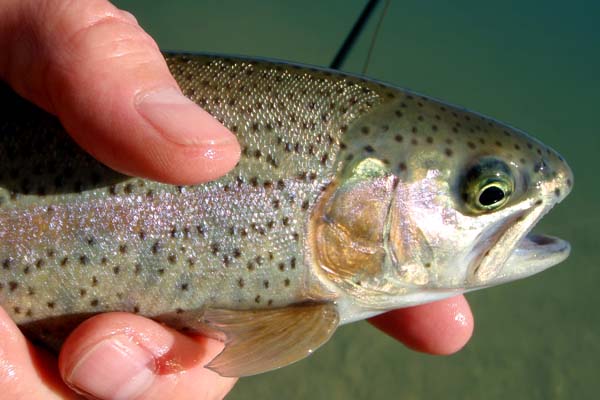
After an hour or so I asked a few obligatory questions: how long have you lived in Las Vegas?, where did you move from?, what do you do for a living?, etc.. As I have often noted, coincidences seem to occur when I’m out fishing. It turned out Mitch and I work for the same employer. I asked about his supervisors and managers, and I discovered I know them all very well. Sadly, we discussed the impending budget cuts at work and their potential impact on his employment. His revelation put a slight pallor over my morning adventure. You see, I was using this little excursion to clear my mind of thoughts about balancing budgets through cutting of programs. I never imagined running into a fellow employee who was at risk, so to speak. Perhaps Mitch was there to clear his mind, to re-assess his future amid the economic uncertainties. Interesting how the Lord puts things into motion sometimes. I will say a special prayer for my fishing buddy, Mitch, as well as all the others awaiting their fates as we finalize our fiscal year 2011 budget. If Mitch’s job becomes a casualty of the impending budget cuts at least I know he will find much solace while fly fishing for trout, wherever that may lead him.
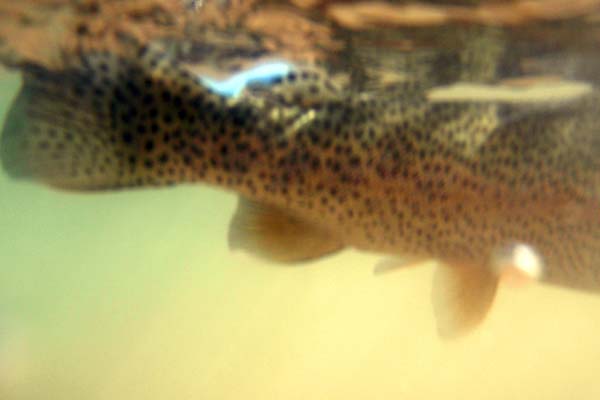
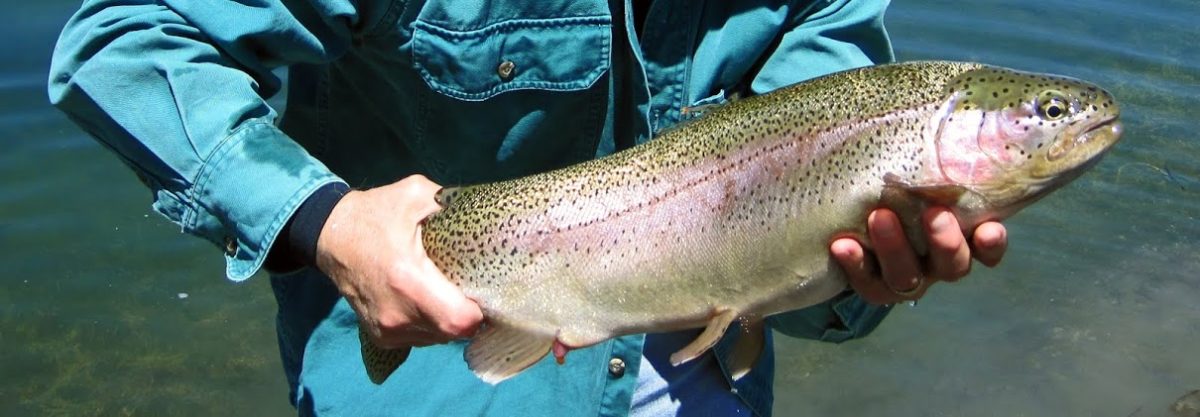
Mark: You have been tantalizing us with your excellent pictures of trout and fly-fishing might I ask what type of camera are you using.John in lv
Hey John, good to hear from you. The weather is warming and fishing is beckoning, isn’t it?! Good question about he camera. Funny thing is it’s probably not the camera or photographer… it’s technology.
My most recent pictures over the last 2 years were taken with an Olympus Stylus 850 SW (8.0 megapixels). I bought this camera a couple of years ago because it was shockproof and waterproof (in fact, as you see in this blog, it can take underwater pictures). Similar to my previous camera, it can take movies and has a macro setting for extreme close-ups. I have somewhat mixed feelings about this camera as it takes horrible indoor pictures… the flash is too weak on this camera, in my opinion. Indoor flash pictures come out too grainy.
From about 2004 to 2008 I used a Cannon Power Shot A510 (3.2 megapixels). I really liked the quality of pictures this camera produced, but I longed for more pixels (pixel envy) and waterproofing in a more compact frame, which led me to the Olympus. I have learned to use the Cannon for night time family photos, but the Olympus remains my choice for outdoor adventures.
But the real thing that makes up for my errors and camera faults is Adobe Photoshop software. My son, Nick, introduced me to Photoshop which he uses in his line of business. Not only can it adjust over/under exposure, brightness and contrast, color balance/saturation, and crop framing of the picture, it can perform miracles with “healing” and “cloning” tools. For example, if you ever fished Cave Lake (refer to August 14, 2009 blog: https://www.fisherdad.com/2009/08/14/cave-lake-white-pine-co-nevada/) you would recognize that the two pictures of me wading near the boat dock have been doctored. Above my head in the picture captioned “Changing flies” there is a parking lot with 4 trucks, a trailer, and a cluster of State Park buildings… I simply cloned them out to enhance the feeling of “wildness”… a little cheating to make the picture more appealing to the eye. Similarly, in the picture captioned “Casting along the reeds near boat dock”, just above the weeds over my head should be a yellow sign, and inside the leading arc of my cast was a photovoltaic solar panel seemingly rising out of the reeds. I cloned both out for the same reason. Cloning trees and grasses is very effective because irregularities in the cloning appear natural. There are several versions of photo software out there, and I recommend them for anyone semi-serious about photography. It can make a boring picture interesting, and can certainly fix problems with color and lighting.
Oh, and the picture of Mitch at the top of this February 15 blog had the outflow pipe showing on the left edge of the picture. I cloned that pipe out. If you click on that picture and enlarge the browser image to 150% you'll notice that the reflection of the rocks along the shore doesn't really look right. But the untrained eye would never notice and the absence of that pale-blue pipe makes the composition so much better. Sneaky, huh!
Mark, Went to cold creek this morning for a few hours with no luck. Maybe I will go back when they stock again. What flys are you having success with out there? Im new to fly fishing and your help would be appreciated. Got the casting down, just need to get the right fly! Thanks, Rob
Rob —
I'm not sure how hot that little pond got this summer, and being so shallow I would wonder about oxygen levels. I was surprised to find trout in the pond as late as April 24, and then Jared posted a June 12 comment that he caught a couple in the middle of June (see https://www.fisherdad.com/2010/04/24/cold-creek-nevada/). But remember June was unusually cool for us this year. Trout survival in that little pond through July and August has to be dubious as best. First stocking should be the latter half of October. You can check on the stocking using the NV Department of Wildlife link I provided above.
Ok, the temperature impact on trout mortality aside, any small fly will work at Cold Creek. Stay around size 14 or 16. My favorite "nymph" patterns on Cold Creek are Hares Ear, Prince, Copper Johns, and even smaller (18) midge and scud patterns will work. The trick is in varying your retrieve pulse and speed until you find a combination that works. On the "dry fly" side, stick to Adams, Caddis, and Black Gnat patterns. With a dry fly you’ll want a dead drift (or float), so you simply cast and wait until you get a strike.
But, if you think you have fly casting down well enough to fish I’d visit Pine Valley Reservoir. It’s a two-hour drive from Las Vegas (just northwest of St. George), all on paved roads. A four-hour round trip could net you six to eight hours of fishing, a ten to twelve hour adventure. You can cast off the dam, but I prefer the inlet side; either of those locations will permit you some grace on overhead casting. Until Cold Creek is stocked this is your best opportunity to practice with a high probability of a hook up, reasonably close to home. If interested see: https://www.fisherdad.com/2006/11/22/pine-valley-ut/. At Pine Valley you can use the same flies I just described as well as larger Wooly Buggers in shades of green, brown, or black.
Good luck.
— Mark